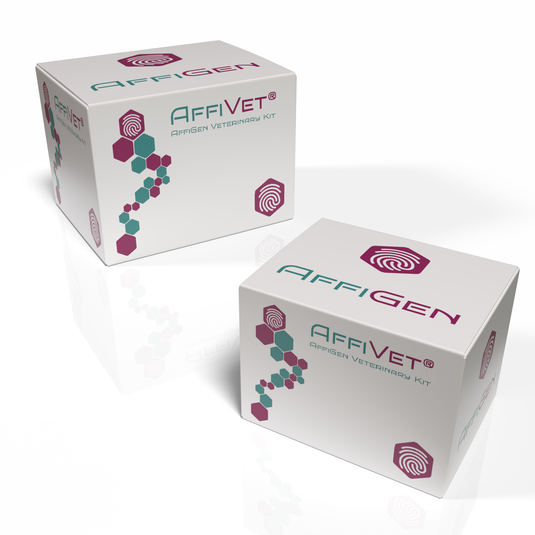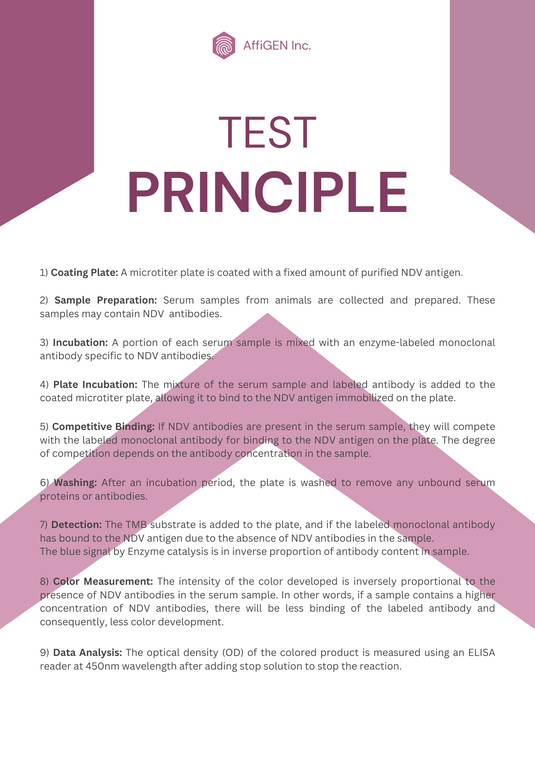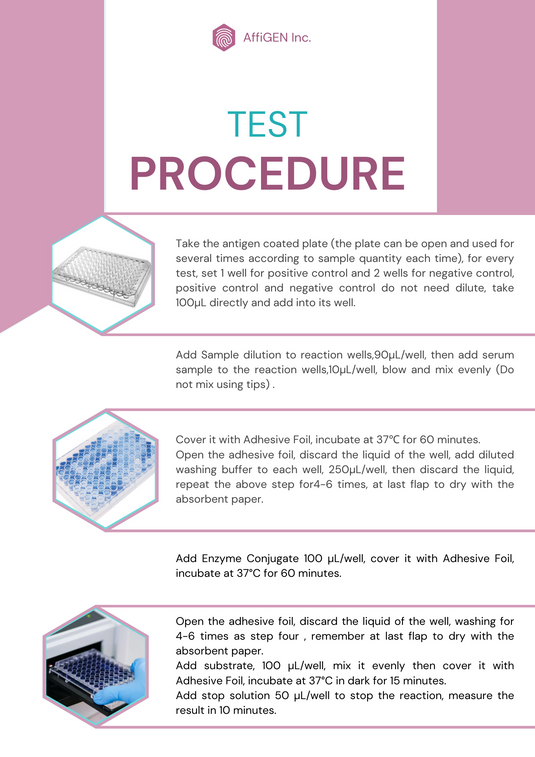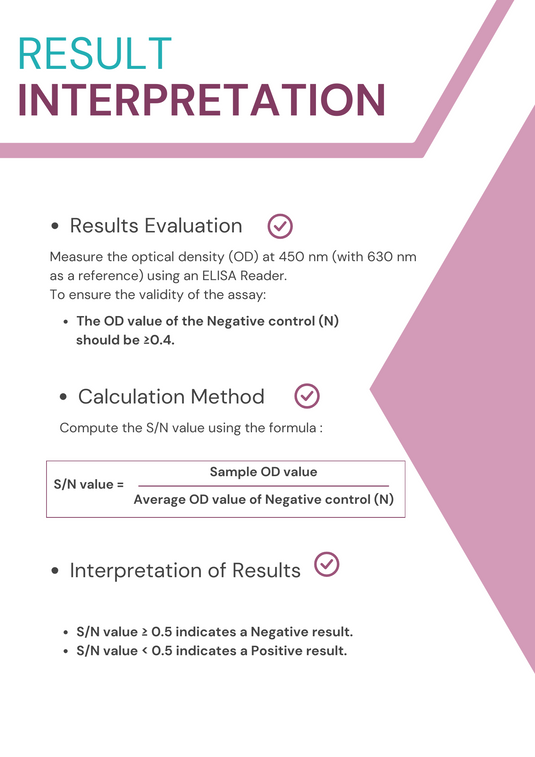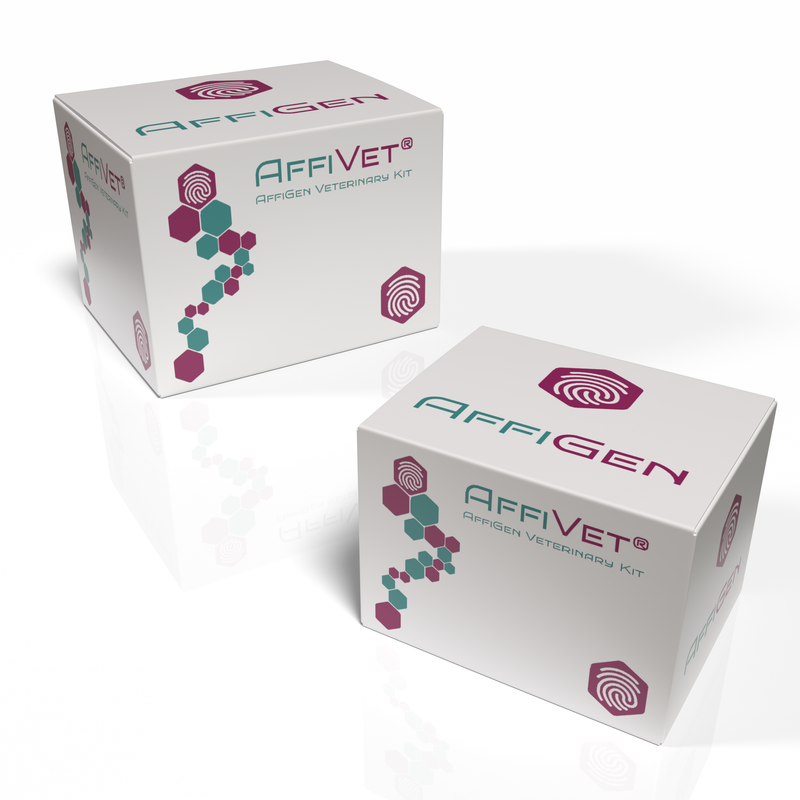
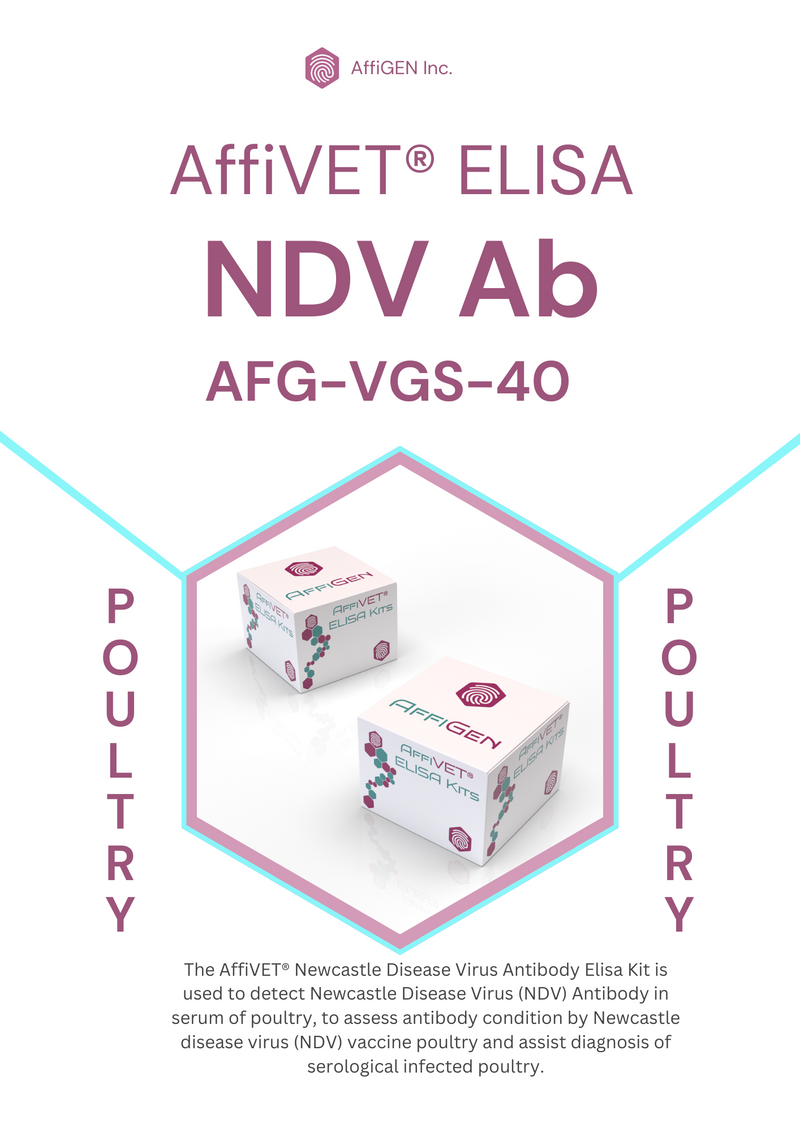

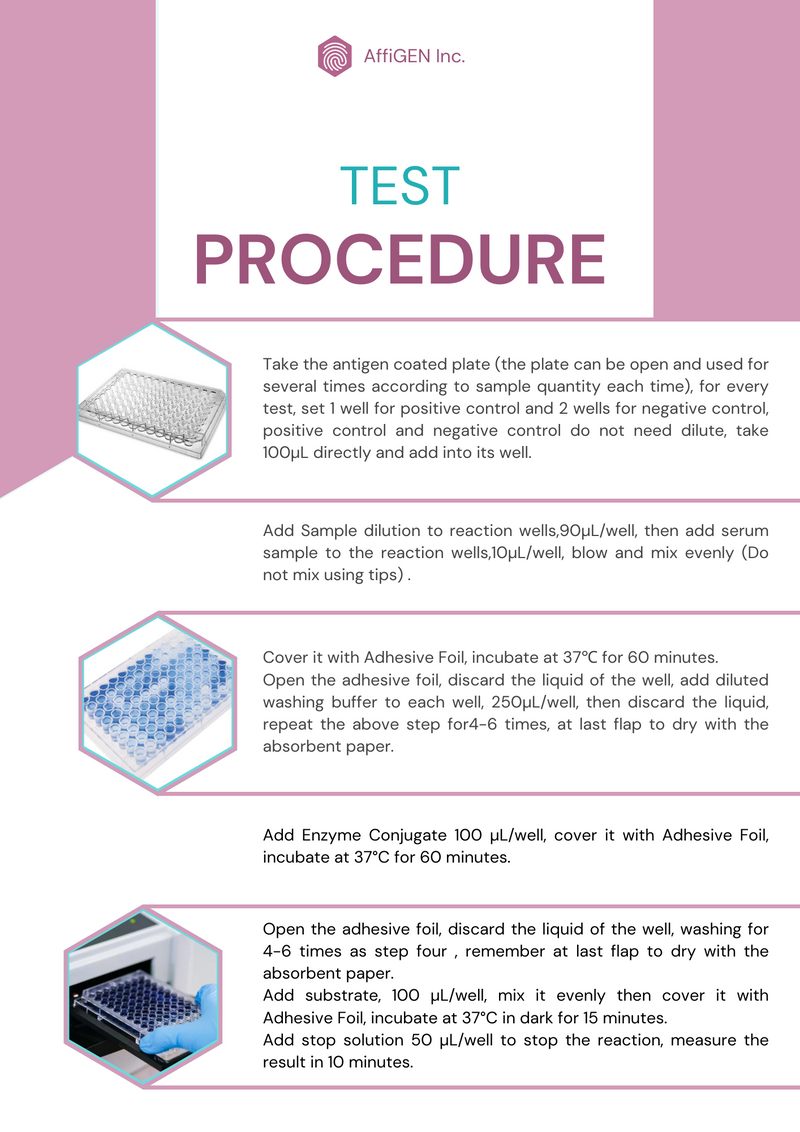

AffiVET® Newcastle Disease Virus Antibody ELISA kit
Introduction :
The AffiVET® Newcastle Disease Virus Antibody Elisa Kit is used to detect Newcastle Disease Virus (NDV) Antibody in serum of poultry, to assess antibody condition by Newcastle disease virus (NDV) vaccine poultry and assist diagnosis of serological infected poultry.
Test Principle :
-
Coating Plate: A microtiter plate is coated with a fixed amount of purified NDV.
-
Sample Preparation: Serum samples from animals are collected and prepared. These samples may contain NDV.
-
Incubation: A portion of each serum sample is mixed with an enzyme-labeled monoclonal antibody specific to NDV antibodies.
-
Plate Incubation: The mixture of the serum sample and labeled antibody is added to the coated microtiter plate, allowing it to bind to the NDV antigen immobilized on the plate.
-
Competitive Binding: If NDV antibodies are present in the serum sample, they will compete with the labeled monoclonal antibody for binding to the NDV antigen on the plate. The degree of competition depends on the antibody concentration in the sample.
-
Washing: After an incubation period, the plate is washed to remove any unbound serum proteins or antibodies.
-
Detection: The TMB substrate is added to the plate, and if the labeled monoclonal antibody has bound to the NDV antigen due to the absence of NDV antibodies in the sample. The blue signal by Enzyme catalysis is in inverse proportion of antibody content in sample.
-
Color Measurement: The intensity of the color developed is inversely proportional to the presence of NDV antibodies in the serum In other words, if a sample contains a higher concentration of NDV antibodies, there will be less binding of the labeled antibody and consequently, less color development.
- Data Analysis: The optical density (OD) of the colored product is measured using an ELISA reader at 450nm wavelength after adding stop solution to stop the reaction.
Kit components :
|
1 |
NDV Antigen Coated Microplate |
1X 96 Tests |
2X 96 Tests |
|
2 |
Enzyme Conjugate |
11 mL |
22 mL |
|
3 |
10X Concentrated Washing Buffer |
100 mL |
100 mL |
| 4 | Substrate |
11 mL |
22 mL |
|
5 |
Sample Dilution | 100 mL | 100 mL |
|
6 |
Stop Solution |
15 mL |
15 mL |
|
7 |
Positive Control |
1 mL |
1 mL |
|
8 |
Negative control |
2 mL |
2 mL |
|
9 |
Adhesive Foil |
2 PCE |
4 PCE |
|
10 |
User Manual |
1 PCE | 1 PCE |
Materials Required But Not Provided :
-
Microplate Reader (96 wells with 450/630 nm wavelength).
-
Precise micropipette : 10uL - 100uL & 100uL-1000uL.
-
Graduate: 500 mL .
-
Disposable pipette tips.
-
Distilled water or deionized water.
-
Bottle washer or Microplate Washer.
Sample Preparation :
1. Take animal whole blood.
2. Prepare serum according to regular methods.
NOTE : The serum should be clear, have no hemolysis.
Washing Buffer Preparation :
1. Return 10X Concentrated Washing Buffer into room temperature before use, if there is salt crystals.
2. Shake to make it dissolved.
3. Dilute it at 10 times with distilled water or deionized water.
NOTE : The diluted washing buffer can store at 4℃ for about 1 week.
Test procedure :
- Take the antigen coated plate (the plate can be open and used for several times according to sample quantity each time), for every test, set 1 well for positive control and 2 wells for negative control, positive control and negative control do not need dilute, take 100µL directly and add into its well.
- Add Sample dilution to reaction wells,90µL/well, then add serum sample to the reaction wells,10µL/well, blow and mix evenly (Do not mix using tips) .
- Cover it with Adhesive Foil, incubate at 37℃ for 60 minutes. Open the adhesive foil, discard the liquid of the well, add diluted washing buffer to each well, 250µL/well, then discard the liquid, repeat the above step for4-6 times, at last flap to dry with the absorbent paper.
- Add Enzyme Conjugate 100 µL/well, cover it with Adhesive Foil, incubate at 37°C for 60 minutes.
- Open the adhesive foil, discard the liquid of the well, washing for 4-6 times as step four , remember at last flap to dry with the absorbent paper.
- Add substrate, 100 µL/well, mix it evenly then cover it with Adhesive Foil, incubate at 37°C in dark for 15 minutes.
- Add stop solution 50 µL/well to stop the reaction, measure the result in 10 minutes.
Results :
To ensure the validity of the assay: The OD value of the Negative control (N) should be ≥0.4.
-
S/N value ≥ 0.5 indicates a Negative result.
-
S/N value < 0.5 indicates a Positive result.
Precautions and warnings for users :
1) Return all reagents into room temperature before use, put the reagents at room temperature for at least 1 hour. Shake it evenly before use, and store back to 2-8℃ after usage.
2) Do not mix use reagents from different kits and different lot number, prevent the reagents been polluted when using.
3) Substrate and stop solution may have irritation to skin and eyes, be careful to use.
4) Do not expose Substrate to strong light and avoid contact with the oxidant.
5) H5 Ag coated plates should be sealed and moisture-proof. Put back unused Micro-Well plate into dry foil bag and sealed at 2-8 ℃.
6) All wastes should be treated well to avoid pollution before discarding.
7) Strict compliance with the operating instructions can get the best results. Pipetting operation, timing, and washing of the whole process must be precise.
8) NDV Ag Coated plates is disposable, do not repeat use.
Storage and Shelf Life :
- Storage: Storing at 2-8℃, in the dark.
- Expiry date: 12 months.

